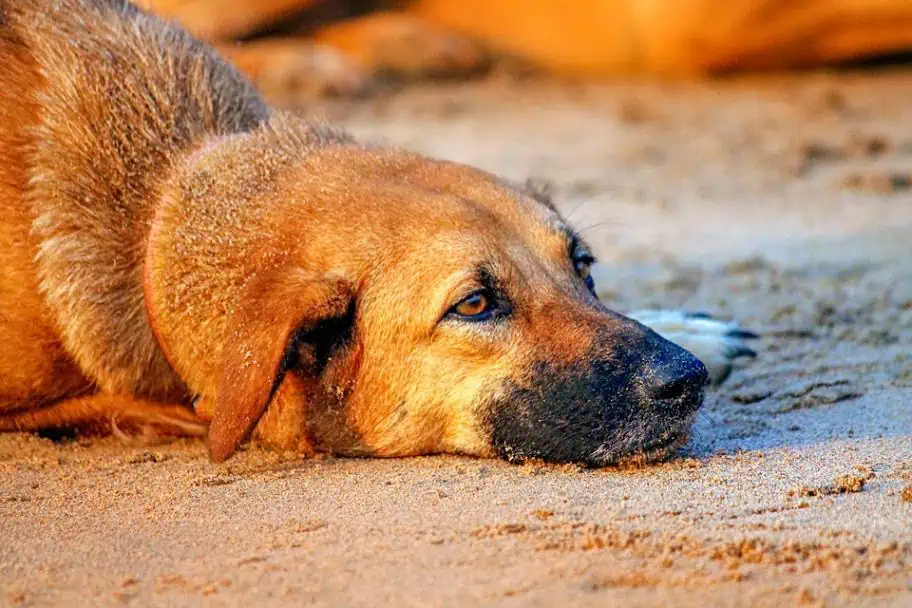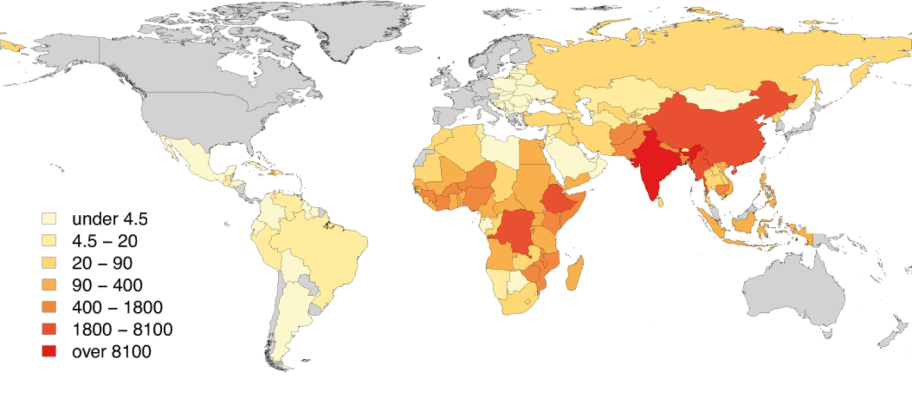LAST UPDATED: 3/2/24 – Why You Should Consider Rabies Vaccination for Travel
IMPORTANT NOTE: I am not a medical doctor and do not have any medical training. I have chosen to write about why I think it is important for people to get Rabies vaccination for travel because of research that I have done about the virus, the potential for exposure, the seriousness of the infection, and horror stories that I have heard from other travelers who have been exposed. I am sharing this information with you because I care about your well-being. My hope is to bring awareness of the risks to you so that you can have a conversation with your doctor about the risks of exposure and protection before your travels.
Rabies Vaccination For Travelers Navigation Menu
| About the Rabies Virus | |
| Ways You Can Get Infected With Rabies | |
| Why I Am Choosing to Get Vaccinated | |
| Rabies Risk By Country | |
| How to Protect Yourself from Rabies |
With the global COVID-19 pandemic, travel health has certainly been in the spotlight for the past few years. While we have a ways to go worldwide before we can finally put this health crisis behind us, that doesn’t mean that we are as close to controlling all of the health crises that continue to plague the people of this world.
Unfortunately, some of the most serious and most enduring of these world health crises seem to disproportionately plague the poorest and least fortunate people in the world. Diseases like HIV, Tuberculosis, Malaria, Yellow Fever, Dengue Fever, Typhoid, Zika Virus, and many others continue to disproportionately kill more people in Africa and Asia than anywhere else in this world.
No matter where we live, it is on all of us to help eliminate deaths from these illnesses in all parts of the world. No one deserves to suffer and lose loved ones from these illnesses.
Make Sure You Consider Malaria Protection As Well
It is also our responsibility to protect ourselves from illness and infection when we travel. Many of us have been vaccinated against such illnesses as Polio, Measles-Mumps-Rubella, Diphtheria-Tetanus-Pertussis, and Hepatitis A and B at some point in our lives.
However, chances are that far fewer of us have been vaccinated against illnesses like Typhoid, Yellow Fever, Japanese Encephalitis, and other illnesses that aren’t endemic to North America, Europe, and other areas of the world outside of Africa and Asia.
To keep yourself, your travel companions, and others you come into contact with safe and healthy, it is your responsibility as a traveler to know which vaccines you should get before traveling and make arrangements to get those vaccines.

Though it may not kill as many people each year as Influenza, Malaria, or other illnesses, one of the oldest and most lethal of all diseases known to man is the rabies virus. Of all the known viruses in this world, the Rabies virus is by far the most lethal.
Rabies Infection is Almost Always Fatal
With an almost 100% fatality rate, a human Rabies diagnosis almost always means an agonizing, painful death. Once symptoms of Rabies start to occur, it is the one illness where there is virtually no hope of recovery.
While human rabies deaths have been significantly reduced in parts of North America and Europe through pet and wildlife vaccination programs, the virus still kills over 50,000 people each year. Most of these deaths occur in parts of Asia and Africa where the main source of infection comes from unvaccinated domestic dogs that roam the streets.
In this article, I am going to explain what Rabies is, how it can be spread to humans, where in this world you are at the most risk for contracting the virus, and why I think it is so important to understand how to protect yourself from this brutal and unforgiving disease.
In doing so, I am going to explain why I have decided to get the Rabies pre-exposure vaccination and why I think more travelers who are thinking about visiting high-risk areas in the world should consider getting the Rabies vaccination for travel so that they are protected.
I understand that the talk of vaccinations can stir up strong emotions in people, but I do think it is important for you to understand the facts about this lethal virus so that you have all the information available to make the best decision for you and your health as you explore this beautiful world that we live in.
About the Rabies Virus

According to a history of Rabies, the earliest known reference of Rabies dates back to 2,300 B.C. in the Babylonian city of Eshnunna, where residents were fined if bites from their dogs resulted in a Rabies death. This makes it one of the oldest known diseases to affect humans, in addition to being the most lethal. Up until the 1880s, when French chemist Louis Pasteur and his assistant Emile Roux developed the first vaccine for Rabies, a human infection almost always led to death.
Per the Centers for Disease Control, the Rabies virus is classified as a zoonotic disease, which means it primarily affects other animals but can be spread to humans. It is a neurotropic disease, which means the virus infects the nervous system of infected animals.
Upon infection, the virus spreads slowly in the muscles and tissues at the wound site until it reaches peripheral nerves. When it reaches the nervous system, the virus travels to the spinal cord and then up into the brain. Once in the brain, the virus multiplies rapidly, ultimately leading to encephalitis (or swelling of the brain) and ultimately death.
It’s Critical to Get Treatment Before Rabies Reaches the Nervous System
The one saving grace of Rabies infection is that after initial exposure, the virus replicates very slowly in the muscle and tissue until it reaches the periphery nerves. According to the World Health Organization’s Rabies Fact Sheet, this lengthy incubation period provides a great opportunity for immunization against the virus post-exposure to prevent the virus from infecting the nervous system and leading to death.
As long as the correct post-exposure prophylaxes (PEP) procedure is followed, the probability of preventing Rabies infection is very good. This is why it is so important to not only understand how to avoid exposure in the first place when traveling but to also understand the proper procedures for Rabies vaccination for travel.
Ways You Can Get Infected With Rabies
The virus can be spread to human beings through a bite or scratch by an infected animal, an infected animal licking an open wound, or by an infected animal’s saliva coming into contact with your mucous membranes, such as those in your eyes or mouth.
What most people don’t understand is that it doesn’t even need to be a serious bite to cause infection, as any scratch or minor bite by an infected animal can lead to Rabies infection. Many people also don’t realize that animals infected by Rabies don’t always act vicious and froth at the mouth. An animal that you come into contact with might not act like it is infected, but may still carry the disease.
Important Rabies Exposure Facts
- Any mammal can carry the rabies virus. This includes domestic animals like dogs, cats, ferrets, and rabbits, farm animals like horses, cows, and goats, or wild animals like bats, foxes, raccoons, skunks, wolves, or coyotes.
- The most common vector for human rabies infection in Asia and Africa is the domesticated dog, while the most common vector for human infection in parts of Europe, North America, and Australia are wild bats.
- You don’t need a serious animal bite to be infected by rabies. Rabies can be spread by any bite or scratch that breaks the skin, by an infected animal licking an open wound, or by an infected animal’s saliva coming into contact with your eyes or mouth.
- Animals infected by rabies don’t always act like they are rabid. Animals who are infected by Rabies may act timid shy or out of character with how they normally act. Any wild animal that shows no fear of humans or is acting in unnatural ways (like a bat that is out during the daytime) should be avoided.
Recent Stories of Rabies Travel Deaths
In case you haven’t seen them, there are quite a few nightmare stories about travelers who have died of Rabies after having seemingly minor exposures to animals that they had no clue were infected.
Just a few years ago, a Norwegian woman died of Rabies shortly after receiving a small bite from a puppy that she handled while traveling in the Philippines.
It’s a similar story to an American woman who also died of Rabies recently after being bitten by a puppy while on a yoga retreat in India. However, it isn’t just dogs that have infected travelers.
While vacationing in Morocco, a UK man received a small bite from a cat during his visit, but didn’t get vaccinated for Rabies until many weeks later, and ultimately died of the disease because of it.
These are just some of the many stories out there about travelers who didn’t understand the exposure risks or the importance of getting the proper Rabies PEP as soon as possible. These stories are also why I think that getting a rabies vaccination for travel will help provide you with peace of mind as you travel.
Why I Am Choosing to Get Vaccinated

In case you don’t follow my blog closely, I am planning on taking a trip to Egypt, Jordan, and Israel this autumn. While reading the Centers for Disease Control vaccination recommendations for Egypt and Jordan, I noticed the following guidance concerning rabies for both of those countries:
Rabid dogs are commonly found in Egypt (and Jordan). If you are bitten or scratched by a dog or other mammal while in Egypt, there may be limited or no rabies treatment available.
Centers for Disease Control Guidance on Travel to Egypt and Jordan
This led me to do some additional research about whether other travelers have decided to get Rabies vaccination for travel to these and other parts of the world where Rabies exposure is more common.
In case you aren’t aware, there is a Rabies pre-exposure prophylaxes (PEP) regimen that will simplify the post-exposure vaccination process if you are exposed and make it much easier to get treatment if exposed overseas. I outline the pre-exposure Rabies vaccination process and its benefits in the section on How to Protect Yourself below.
Nightmare Rabies Exposure Experiences Told by Travelers
As I started to read about the experiences that other travelers have had with Rabies exposures while traveling overseas, I started to realize just how difficult it can be to find the proper treatment while traveling and just how big of a nightmare it can be to try and get the proper Rabies PEP in time.
Here are just a few of the first-hand experiences I read from other travelers who had Rabies exposure overseas and had a nightmare experience trying to get the proper treatment in time.
- How a Rabies Scare Changed the Way I Want to Travel
- I was bitten by a feral dog while overseas. My search for rabies shots was a terrifying ordeal.
- Rabies scare has woman turning to doctor half a world away
Rabies Risk By Country

If you have upcoming international travel plans or know that you might be traveling internationally in the future, you may want to consider getting the Rabies vaccination for travel. For a better understanding of what type of risk there is to being exposed to Rabies in different parts of the world, I have included a chart from the World Health Organization (WHO) below for you to review and make your own assessment.
Number of Annual Rabies Fatalities per Country

How to Protect Yourself from Rabies

Thankfully, a lot has changed since the days when exposure to Rabies meant a certain horrifying death. With the introduction of the Rabies vaccine in the 1880s, the number of human deaths from this terrorizing virus has plummeted.
With the proper knowledge and treatment, no one in this world has to die from this virus. In fact, the Rabies vaccines themselves have come a long, long way since the days when they required a series of painful injections into the abdomen.
The modern Rabies vaccination shots are given in the deltoid muscle of your arm. This makes getting the Rabies vaccination for travel as easy as it is to get the COVID-19 vaccination and many other vaccinations that you receive.
Post-Exposure Vaccination
If you receive an animal bite or other exposure to Rabies while traveling overseas, you will need to make sure you follow the proper protocol for Rabies post-exposure prophylaxes. According to the Centers for Disease Control, this includes the following (this schedule must be STRICTLY followed):
- Immediately – Wash wounds thoroughly for 15 minutes using soap, iodine, or alcohol.
- Day 0 – Rabies Vaccine Shot and Rabies RIG (see below)
- Day 3 – Rabies Vaccine Shot
- Day 7 – Rabies Vaccine Shot
- Day 14 – Rabies Vaccine Shot
However, to be certain that you won’t get Rabies after exposure, the post-exposure PEP process also includes a shot of Rabies Immunoglobulin (RIG) into the exposure site (where you were bitten) immediately with your first Rabies vaccination shot.
This shot of RIG gives you immediate protection against Rabies until the Rabies vaccine shots allow your body to build up its own natural immunity.
Most of the deaths that have occurred in people who have received Rabies vaccinations have occurred because they didn’t follow the strict World Health Organization and Centers for Disease Control protocols for Rabies vaccinations, including not receiving post-exposure shots of RIG.
Risks to Relying on Post-Exposure Vaccination While Traveling
Although the HRIG shots have proven effective in protecting people from Rabies immediately after exposure, there are some drawbacks to relying on Rabies post-exposure PEP (including RIG) that make getting Rabies pre-exposure PEP a very prudent option. These include the following:
- In some countries, Human Rabies Immunoglobulin (HRIG) is unavailable, and the only option is Equine Rabies Immunoglobulin, which can have serious side effects. Essentially, Rabies Immunoglobulin is a Rabies antibody that is taken from subjects who have built up an immunity to Rabies. For Human Rabies Immunoglobulin, the plasma from people who have received the Rabies vaccine is taken and made into antibody shots that can be injected into the bite wounds of other exposed individuals to give them immediate protection. On the other hand, Equine Rabies Immunoglobulin is plasma taken from horses who have been vaccinated against Rabies. Because it comes from horses, not humans, the side effects of these shots can be much more severe.
- In some cases, RIG of either kind can be hard to find overseas, which means you will need to either get medically evacuated from the country to get the proper shots or scramble from hospital to hospital looking for immunoglobulin.
- Even if you do find Human Rabies Immunoglobulin, it can be quite expensive. There are a ton of stories out there from people who have had to get Rabies HRIG shots, only to get $10,000-$20,000 medical bills for the treatment, after their insurance paid their share. For instance, a biologist bitten by a cat in the Everglades got a $48,512 medical bill for her Rabies treatment, while a woman in New Jersey was charged over $24,000 to treat her rabies exposure from a fox bite.
Pre-Exposure Vaccination
If you are interested in getting the Rabies vaccination for travel, you should fully understand the benefits and the process before committing. It is recommended that you don’t start the pre-exposure vaccination process unless you can finish the protocol completely. According to the Centers for Disease Control, there are many advantages to getting the Rabies pre-exposure vaccinations before traveling:
Although pre-exposure vaccination does not eliminate the need for additional therapy after a rabies exposure, it simplifies management by eliminating the need for rabies immune globulin and decreasing the number of doses of vaccine needed. This is of particular importance for persons at high risk for exposure to rabies in areas where immunizing products might not be available or where lesser quality biologics might be used which would place the exposed person at increased risk for adverse events.
Pre-exposure prophylaxis may also protect people whose post-exposure therapy is delayed and provide protection to people who are at risk for unapparent exposures to rabies.
Centers for Disease Control (CDC)
In my opinion, the most important advantage is that Rabies Immunoglobulin is unnecessary if you have had pre-exposure vaccinations. In fact, according to many health organizations that I have checked, including the CDC, they recommend not getting the HRIG shot if you have had the pre-exposure vaccinations as it will actually hinder your body’s ability to create the Rabies antibodies on its own.
The reason you don’t need to get the HRIG shot when you have had the pre-exposure vaccination shots is that your body has immune memory cells that can create the necessary Rabies antibodies much faster than someone who hasn’t had the Rabies pre-exposure vaccination shots. That is also why you don’t need to get as many shots after being exposed if you have had the pre-exposure vaccinations, which is another advantage to getting them.
According to the Centers for Disease Control, the protocol for Rabies pre-exposure prophylaxes includes the following:
- Day 0 – Rabies Vaccine Shot
- Day 7 – Rabies Vaccine Shot
- Booster – Between 3 weeks and 3 years following the second shot
NOTE: The CDC recently changed the prescribed pre-exposure regimen from a 3-shot prophylaxes regimen to a 2-shot prophylaxes regimen.
After Exposure, the following additional shots will be needed:
- Immediately – Wash wounds thoroughly for 15 minutes using soap, iodine, or alcohol.
- Day 0 – Rabies Vaccine Shot
- Day 3 – Rabies Vaccine Shot
Don’t Forget to Subscribe to My Adventures!

Let Me Help You Save On Your Next Adventure!
‘Start Exploring Today’ Merchandise Available Now!













Thanks for the great tip about rabies Josh. Honestly this is something I never thought about. Great advice, and a great post!
Thanks Tim!
This was a really great post. I don’t think too many of us would really ever think about rabies until it was too late. You pointed out some scary, but really important considerations. Even a cat scratch or dog scratch and there goes your life. Yes, thank you so much!
No problem! I really wasn’t aware of a lot of the risks and the consequences until I read the CDC guidance either. It was very eye opening. I thought it was important to bring this to other’s attention so that people could access for themselves. I am so glad to hear that you found it useful. Thanks! 😀
👍👍
This is something I never really thought about, thanks for sharing!
You are very welcome Diana!
As a pharmacist I had never heard of pre-exposure prophylactic rabies treatment. Thanks. I can see how this would be useful in certain high risk conditions. Please get back to us on what process you are going to use to get the rabies vaccine- probably some sort of travel clinic in a hospital and what out of pocket costs you might run into. I’m pretty sure this would not be covered by insurance but who knows because this is new territory for me. Normally HRIG and gamma globulin are provided free through each state Department of Health but administration is charged by the hospital. If you are choosing to get it for travel I have to think this is going to cost quite a bit but you should check on that first.
You are very welcome George! I have already had two of my three pre-exposure shots. I had a travel consult with my doctor, and she agreed that the pre-exposure vaccination was appropriate for me. The clinic then ordered the doses of RabAvert (the other brand available is Imovax). I made my three appointments for the injections in advance as the schedule is critically important for this vaccination. I hope this helps! 😃
Forgot to add – The shots are covered by my insurance. I called to ask ahead of time. I looked it up snd the average cost of the injections for those with insurance is around $150/injection. My vaccinations were completely covered. Without insurance, the shots cost about $450/injection.
Also, the advantage of getting the pre-exposure vaccinations are that you don’t need the HRIG if exposed. That can be difficult to find in some countries when traveling and is the leading cause of PEP failure (along with not properly washing the wounds) in post-exposure. Even if you do find globulin overseas if exposed, some countries only use equine globulin, which can have serious side effects. It’s up to each traveller to access for themselves, but I’d rather pay for the pre-exposure vaccination and not have to worry about finding HRIG in time if exposed and only have to worry about scheduling two vaccinations instead of 4 while abroad.
Thanks for your input and the discussion. You brought up some great points that I didn’t touch on in my article that need to be considered by travelers!
Thanks for the info and safe travels!
Thanks George!